How to sell subscriptions on Shopify: Best apps, accounting and tips
There are now a massive variety of ways you can sell subscriptions on Shopify as either your main business model or as a supplementary category. However, with subscriptions come unique challenges and considerations. If done right, subscriptions can guarantee your e-commerce business regular cash flow and customer loyalty.
In this article, we’ll go through why you should offer subscriptions to your customers and the different types of subscriptions available. From there, we’ll discuss how to price your plans, getting started with the best subscription app for Shopify, and how to convert potential customers. Finally, we’ll explain how to manage your accounting and bookkeeping.
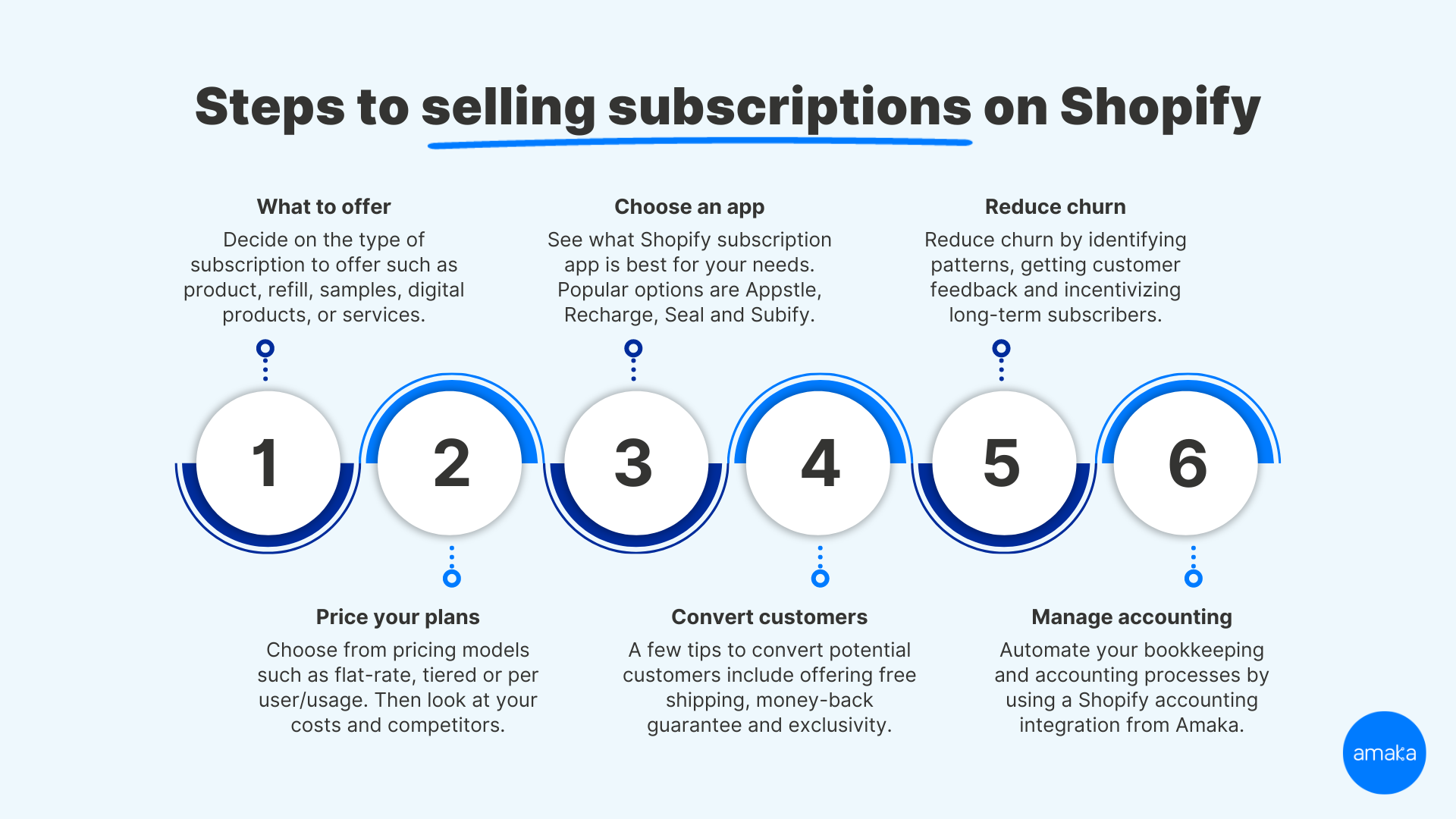
Can you sell subscriptions on Shopify?
E-commerce stores hosted on Shopify can sell subscriptions where customers make recurring payments to receive goods or services on a regular basis, usually monthly or quarterly. However, it’s not an in-built feature and will require you to install an app from the Shopify App Store.
Shopify offers its own Shopify Subscriptions app for free, or, you can look to implement a third-party subscriptions app from the app store. We’ll go into more detail on the leading app options later on.
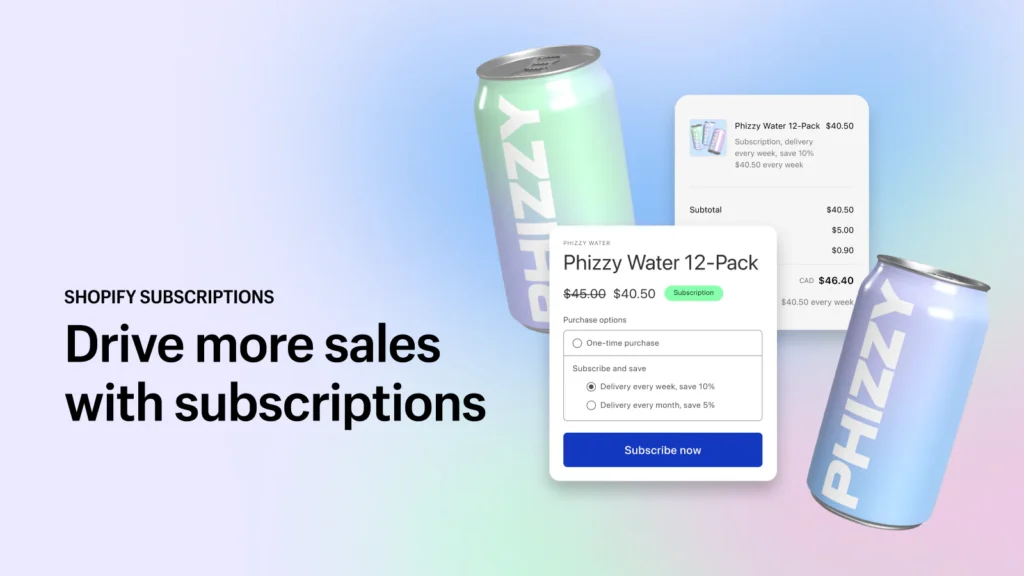
Advantages of offering subscriptions
Selling subscriptions on Shopify can be beneficial to your business in a number of ways. Despite subscription models being around for awhile now, we’re still expecting to see a massive growth in e-commerce subscriptions specifically. A recent report on the subscription e-commerce market found that the market reached US $193.6 billion in 2023 and is expected to reach US $5,014.4 billion by 2032.
Here are just a few reasons why you should consider jumping into this growing opportunity:
- Better customer experience: First and foremost, with subscriptions, customers typically get discounted pricing, convenience, automatic deliveries, customization, and/or exclusive items.
- Customer retention: By creating a regular and ongoing interaction with customers, you can more easily foster brand loyalty and overall satisfaction.
- Upselling and cross-selling: Additionally, the retention means you get regular opportunities to upsell and cross-sell products or services to your customers.
- Customer lifetime value: The longer customers stay on a subscription, the higher your average customer lifetime value will be. This could mean you could afford to have higher acquisition costs.
- Consistent revenue stream: Subscriptions give your business a steady stream of income that can help with financial planning and cash flow management.
- Easier inventory management: Similarly, subscriptions make inventory planning easier as well by reducing the chance of overstocking or stockouts.
Types of subscriptions you can offer: Example businesses
Nowadays, there seems to be an endless number of ways you can sell subscriptions, regardless of your business model or target market. We’ll go through a select few popular types of subscriptions as well as list a few example businesses.
Product subscriptions
First and foremost, a regular product subscription is one of the most common types of subscriptions. With these, customers receive periodic deliveries of a product or multiple products, such as in a box. This can include pet supplies, beauty products, meal kits, books, etc.
Product subscriptions are often seen in the form of a curated subscription box where customers get a selection of products. For example, BarkBox does themed boxes for your dog with curated treats and toys.
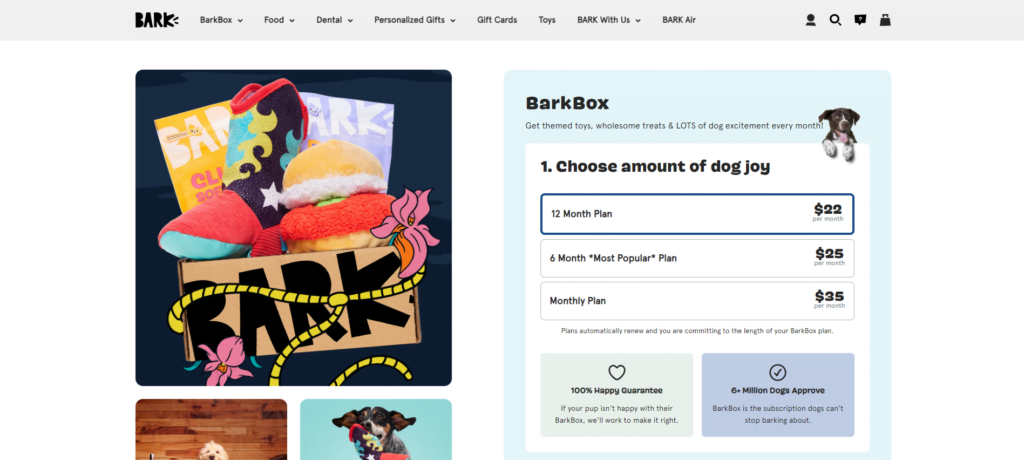
Refill subscriptions
Refill subscriptions are a subset of product subscriptions where customers get regular deliveries of a consumable product that requires consistent restocking. For instance, coffee, vitamins, toilet paper and cleaning supplies.
Skipper is an e-commerce business that sells home and personal care products. They offer the bottles and containers, such as hand soap and body wash, and then sell a regular subscription for just-add-water refill tablets.

Product samples
E-commerce businesses can also offer product samples on a subscription basis to allow customers to get a taste of different products before committing to a full size or simply to get variety. This can include sample sizes of wine, cheese, makeup, skincare products or perfume.
For example, ScentBox sells a subscription box that includes a monthly supply of a designer perfume. This allows customers to have a variety of fragrances without having to commit to a larger size.
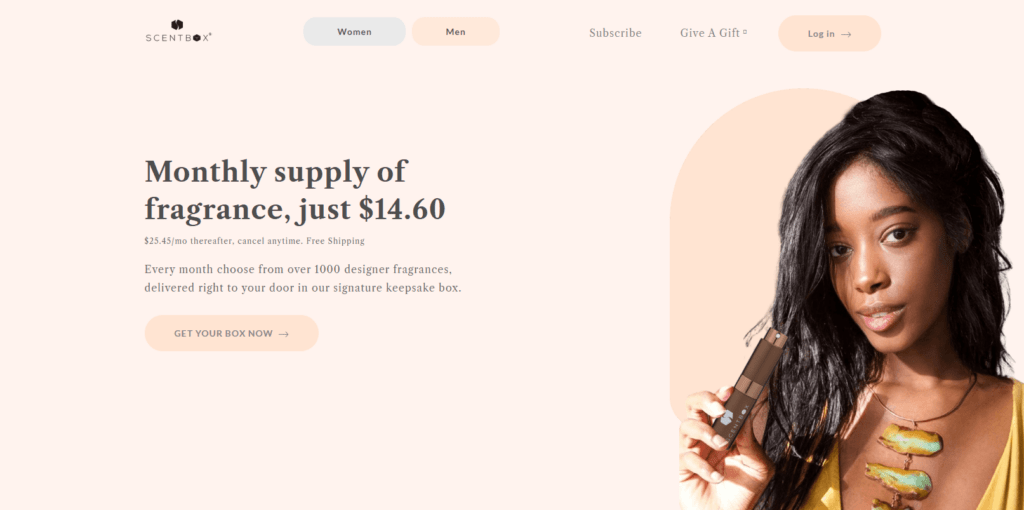
Digital products
Digital product subscriptions work similarly to product subscriptions except that the goods are intangible. These have become popular for businesses because they’re extremely scalable. Common examples include eBooks, music or other audio, digital art, printable planners and calendars, video editing templates, video lessons and sewing patterns.
An example of a business that offers both video lessons and sewing patterns is Seamwork. They offer a monthly subscription that gives you access to regular, new sewing classes and patterns made by their experts.
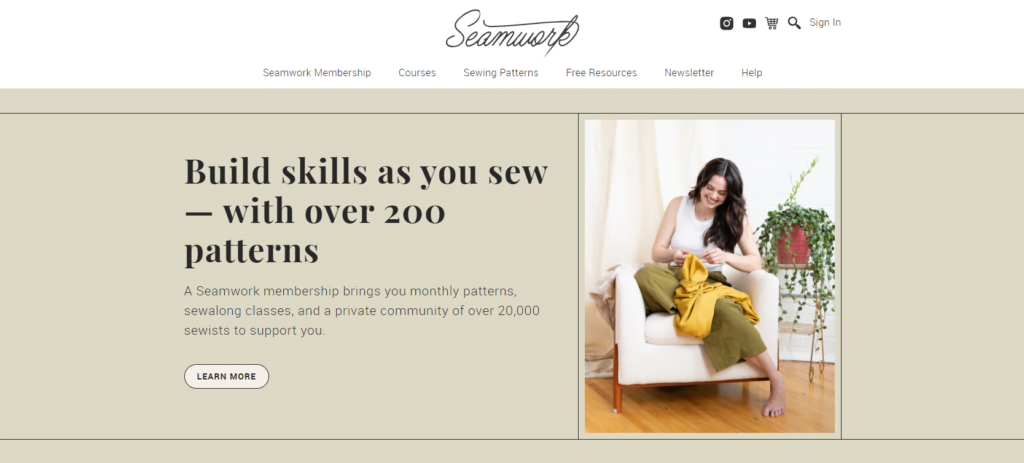
Service subscriptions
The possibilities for service subscriptions you can offer through Shopify are almost unlimited. For instance, you can offer professional services such as marketing or accounting on a subscription basis. Similarly, you can sell software-as-a-service (SaaS) tools such as an accounting automation tool or AI customer support software.
In the same realm, subscriptions can be a way to offer additional/premium services to your customers. This can include free delivery, exclusive deals, priority support or 1-on-1 training. A major example is Amazon Prime where customers get access to free shipping and exclusive deals.
How to price subscription plans
A strong and well-thought-out pricing strategy is often overlooked by businesses that are introducing subscription plans. According to recent pricing benchmarks, companies are only spending ten hours each year figuring out their pricing. Hence, taking the time to crunch the numbers and do market research can give your Shopify business the competitive edge.
The most popular pricing models
In recent research done with merchants, 52% of subscription businesses in e-commerce agreed that flat-rate pricing was the most popular model with customers. This is likely due to its simplicity and is recommended for businesses that only have one buyer persona.
The second most popular was a three tier model, otherwise known as the good-better-best model. This is ideal for businesses with a wider range of buyer personas. After this, we see per user or usage pricing models as a popular option, particularly in the SaaS space.
In summary, the three most common pricing models are:
- Flat-rate pricing: Your business offers one product at a fixed price per interval.
- Tiered pricing: You offer multiple packages, typically two or three, with increasingly more features.
- Per user/usage pricing: You charge based on how many users there are or usage per month. This model is more common with SaaS businesses.
Shopify accounting eBook
Learn how to automate your Shopify accounting and spend less than an hour on your books every month.

How to decide what you should charge
There are three key steps to calculating exactly how much you should charge:
- Figure out your costs: Before you can properly price your subscription plans, you need to know the cost of production, marketing, customer support and any overheads. This ensures your pricing is profitable.
- Research the market: Next, get a lay of the land by analyzing your competitor’s pricing and the purchasing power of your target audience. From there, you can factor in the unique features you offer and how you want customers to perceive the value of your business.
- Test and adjust: Last but not least, don’t forget that there’s always room for improvement. See how the market reacts to your pricing, actively collect feedback and adjust your pricing accordingly. If you do change your pricing, make sure you carefully plan and communicate the transition.
What are the best subscription apps for Shopify?
There are a range of subscription apps, otherwise known as recurring payments apps, for Shopify. After deciding on what type of subscriptions you want to offer and the pricing model you want to use, you need to find an app that suits your unique needs. Below, we’ll go through a few of the best options available to Shopify merchants.
Appstle Subscription
- 4.9 ★, 3,333 reviews
- Free plan available
- Premium plan starts at $10/month (10-day free trial)
Appstle Subscription is great for medium to large Shopify businesses that need more advanced customisation options such as third-party integrations and an API. It supports one of the widest varieties of bundle and subscription types, as well as options for rewards you can offer customers. Additionally, you can choose from almost any pricing model, and access detailed reports and robust analytics. Appstle Subscription has competitive pricing options with an entirely free plan available.
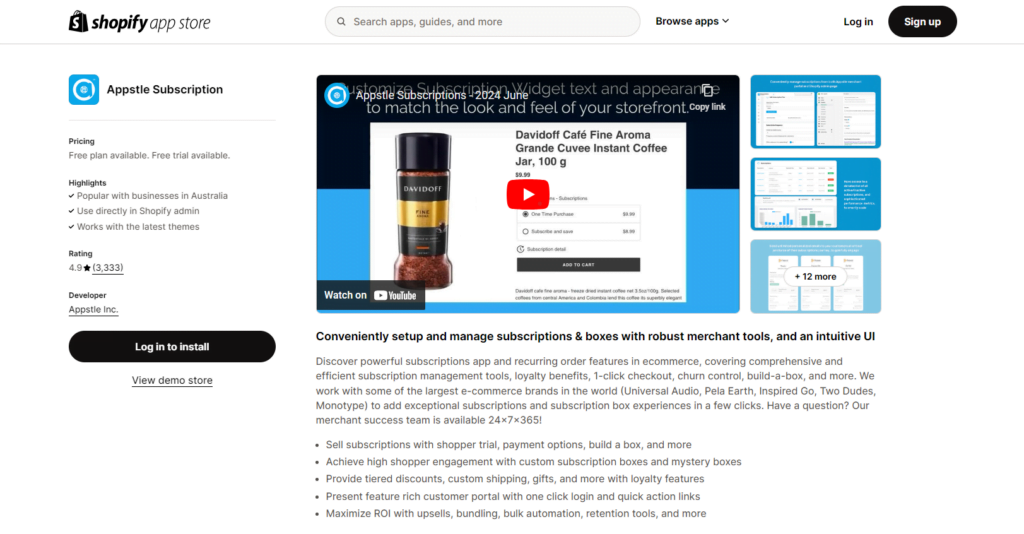
Recharge Subscriptions
- 4.5 ★, 1768 reviews
- Premium plan starts at $99/month (30-day free trial)
Recharge Subscriptions is suited to larger businesses or those that need robust features such as third-party integrations and custom workflows. It allows you to offer one of the widest variety of bundle and subscription types, however, it has a limited number of rewards you can offer customers. Almost all pricing models are available and you can access advanced analytics and reporting tools. Despite the customisation options, it’s known for its easy setup process. Unfortunately, Recharge Subscriptions is priced on the higher end.
Seal Subscriptions
- 4.9 ★, 1667 reviews
- Free plan available
- Premium plan starts at $4.95/month (30-day free trial)
Seal Subscriptions is an affordable option that is ideal for small businesses that require basic features and reporting tools. There is a limited range of bundle and subscription types available, as well as limited rewards you can offer. However, there is a wide variety of pricing models you can choose from. Seal Subscriptions has many design customisation options as well as custom CSS. They offer one of the most competitive pricing plans with a completely free plan.
Subify Subscriptions
- 4.9 ★, 418 reviews
- Premium plan starts at $9/month (14-day free trial)
Subify Subscriptions is another affordable option that would be great for small or medium businesses. Though they don’t have the widest range of features, the variety of bundle and subscription types is decent. Similarly, there is a fair number of rewards you can offer customers. Unfortunately, there is a limited range of pricing models available and only basic reporting tools. Though Subify Subscriptions don’t offer a free plan, their paid plans are priced competitively.
Tips for converting potential customers
You’ve decided what subscription plans to offer and now you need to actually generate sales. There are many tactics you can use to help with converting potential customers. We’ll go through a few of the key strategies that help improve subscription sales for e-commerce businesses on Shopify.
Offer free shipping
In a recent survey on features that drive subscription sales, 38.5% of over 2,000 respondents agreed that free shipping was the leading feature that led to subscription box sign ups. Consider factoring the cost of shipping into the actual subscription cost so that customers don’t have to pay an additional fee for shipping.
Give customers peace of mind
Next, consider how you can give customers peace of mind. The same survey mentioned above found that the ability to cancel at any time was the second-most important factor that drove sales. Separately, you can consider offering a money-back guarantee to make signing up feel less risky.
Give a discount for first-time subscribers
The initial acquisition of a subscriber is the hardest part and therefore, offering a discount for new subscribers can help with getting potential customers over the line. You can offer a percentage discount on the first period or first few periods. Another option is to offer a dollar amount discount. For example, HelloFresh often gives $200 off and spreads it out over the first few weeks.
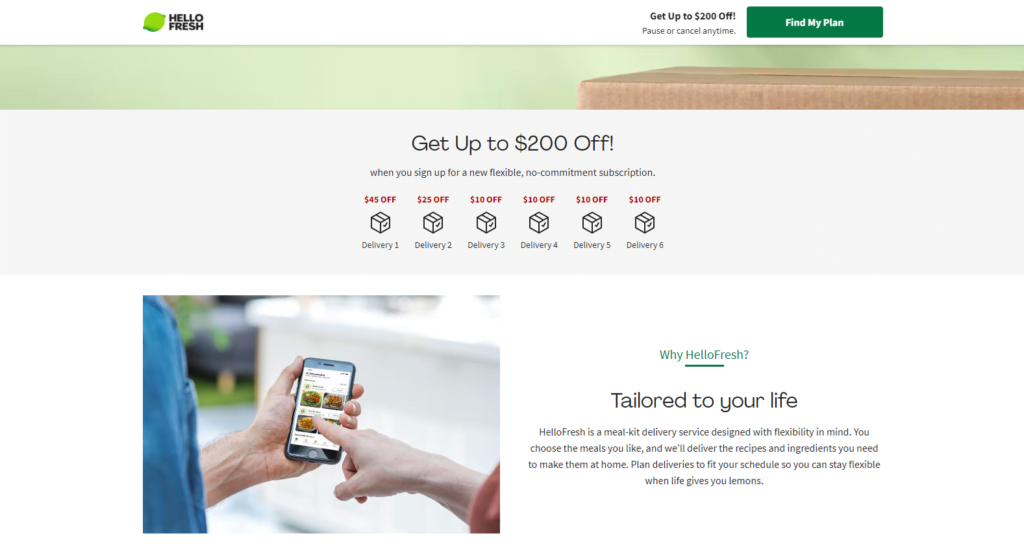
Create scarcity and exclusivity
A unique way to generate sales is to create an air of scarcity and exclusivity. This can be done by limiting the number of subscriptions available, having a waitlist form, and only allowing customers with a password to make a purchase. For example, Illumicrate is a subscription that sells monthly special-edition book boxes. They have premium pricing and have a limited number of boxes available each month.
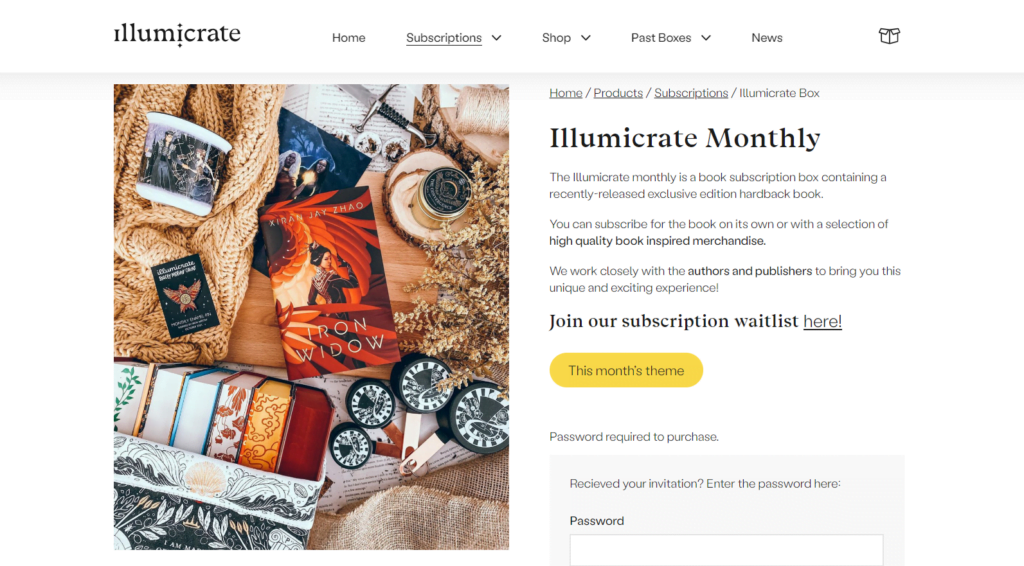
Offer more payment methods
In the previously mentioned survey, 16.8% of respondents found that offering buy-now-pay-later was a leading feature that drove sign-ups. On a similar note, a recent trend report on subscription merchants, 71% of businesses stated that they would be adding additional payment methods.
It’s clear that offering a wide range of payment options for customers is necessary to make sure your business remains competitive. Take time to understand what methods your competitors have available as well as what options are popular for your target market.
Create a seamless checkout experience
Last but definitely not least, the checkout process is crucial to reducing cart abandonment rates. Make sure there are as few steps as possible and only ask for essential information. To help customers make an informed decision, clearly display the price, subscription frequency and inclusions.
How to reduce churn rates on subscriptions
In the same trend report mentioned earlier, 43% of subscription-based e-commerce merchants worldwide believed they would see an increase in customer churn this year. The first step to making sure your business doesn’t see increasingly higher rates of churn is to track when customers are leaving. See if you can identify any patterns related to timing, usage or features.
Next, actively seek feedback from customers to better understand what issues exist. Since feedback from customers who have canceled is particularly valuable, you could offer an incentive for their time. Ensure you engage with customers regularly and prioritize responsive customer support.
Finally, offer incentives for customers who commit to your subscription long-term. For example, you can offer discounts or added benefits for people who subscribe on a yearly plan rather than a monthly one. Furthermore, you can implement loyalty programs where customers earn additional perks, discounts or content the longer they’re subscribed for.
How to manage your accounting for subscriptions
Recording subscription sales is necessary for compliance and can be easy with the right accounting tools. To start, a cloud-based accounting software such as Xero, QuickBooks Online, MYOB or Sage should act as the source of truth when it comes to financial data. These options can integrate with Shopify as well as other tools you might use for inventory, expense, payroll, etc.
Next, connect your store to your accounting software with a Shopify accounting integration such as Shopify + QuickBooks Online from Amaka. Our integrations will automatically sync subscription sales and payments from Shopify into your accounting software on a daily basis. We account for any Shopify fees, meaning your data is always accurate and up-to-date.
Amaka offers completely free plans and free trials for paid plans. To learn more about how you can save dozens of hours on manual data entry, schedule a walkthrough of an integration with the booking form below. If you’re ready to get started, our team can also guide you through the entire setup process.
Key takeaways on selling subscriptions on Shopify
To summarize, there are a range of tools available to Shopify sellers to help with selling subscriptions. By choosing the right ones for your business and planning the processes for marketing and finance, you can ensure you’ve set yourself up for the best chance of success.